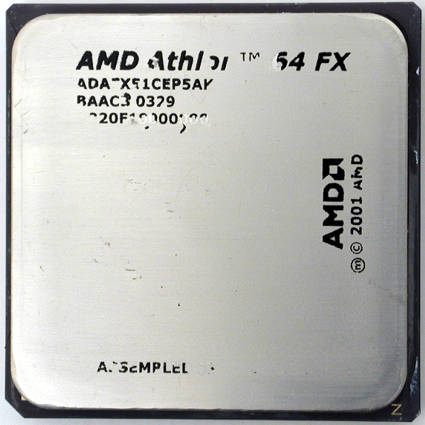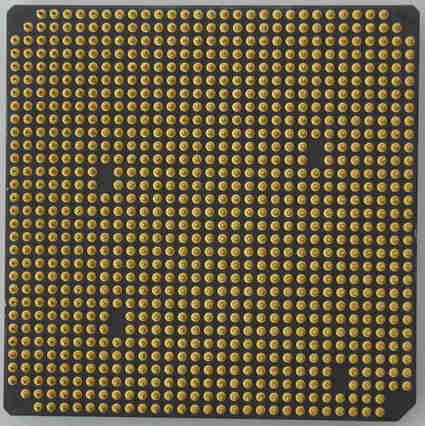Avant-Garde: Four boards for AMD's Athlon 64 FX
Athlon 64 FX 51
Numerous tests have left their mark: The constant positioning and removal of the fan has partly obliterated the product label. Some type of engraving, as on Intel's Pentium 4, would be a good idea.
The Athlon 64 FX needs 940 pins because of its dual-channel memory interface.
Our technology article AMD's Athlon 64 Has Arrived: the Athlon 64 FX and Athlon 64 (and Intel's P4 Extreme) came out just in time for the product launch of the Athlon 64 and Athlon 64 FX-51 processors. We can recommend this as a background article covering the technical basics of the 64 bit Athlon, but here we will just summarize the features of the Athlon 64 FX.
The Athlon 64 FX-51 is the only model available. It works at a system speed of 200 MHz in the DDR process, from which a more marketable 400 MHz can be derived. The core speed is 2.2 GHz, which is usually enough for performance that will put the Pentium 4 at 3.2 GHz in its place. The Athlon 64 gets its added power from its integrated memory interface. This does away with long routes between the processor and the Northbridge; it thus provides only the AGP interface.
Unlike the Athlon 64, the FX has a dual-channel memory interface that boosts the bandwidth considerably. And by the way, it has to be registered DDR-SDRAM. ECC is also supported, but is not necessary.
The following table contains first and foremost the official processor prices for the Athlon 64 and Athlon 64 FX-51:
| Model | Price |
|---|---|
| Athlon 64 FX 51 | $733 |
| Athlon 64 3200+ | $417 |
| Athlon 64 3000+ | $278 |
Athlon 64 Family: Can It Still Be Overclocked?
The multipliers of the Athlon 64 may be of major interest, because unlike with earlier strategies, AMD does not seem particularly interested in preventing overclocking. On the contrary - the Athlon 64 FX CPUs hitherto available to us had no high or low end. No high end means higher multipliers, so that a processor like this can be operated with faster core speed without overclocking the system bus. No low end, in turn, allows for the latter. Even the Athlon 64 (non-FX) includes several factory-installed options, although only the respective lower multipliers are permitted.
Get Tom's Hardware's best news and in-depth reviews, straight to your inbox.
It is currently hard to say what potential the processors we were supplied actually have. A test machine with compressor cooling reached 2.8 GHz in our lab.
Current page: Athlon 64 FX 51
Prev Page In The Spotlight: FX Boards From Asus, Gigabyte And MSI Next Page Memory Matters: Registered DDR
Patrick Schmid was the editor-in-chief for Tom's Hardware from 2005 to 2006. He wrote numerous articles on a wide range of hardware topics, including storage, CPUs, and system builds.

